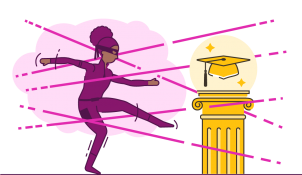Whether memories of your school days are newly formed or ancient history, held fondly or best forgotten, there’s no mistaking the impact that teachers have had on us all. While those of us working to create effective eLearning content may never be presented with a ‘World’s Best Teacher’ mug at the end of term, we can still make a huge impact on learners of any age.
As eLearning creators, we can borrow a lot from the long legacy of classroom instruction. But that doesn’t mean you need a formal teaching qualification to create great eLearning content. Having been through teacher training myself – and taught for several years – I can guide you to some best practice techniques and save you the hassle and sleepless nights that I went through! Here are five simple principles, direct from the classroom, to help you structure and build successful eLearning courses.
1. Set objectives early
Learning objectives are a teaching staple, taking a familiar verb-first format based on Bloom’s taxonomy.. They are used by teachers to deliver the content required by the curriculum, inform students of the areas and understanding they’re expected to master, and measure student performance.
In the classroom, learning objectives typically come in threes, increasing in complexity from low levels of the taxonomy – which focus on building knowledge – to higher levels – which are concerned with building skills and attitudes. For example, in a science class some learning objectives might be:
- Recognise different celestial objects.
- Categorise celestial objects that can be observed from Earth.
- Predict the path of visible celestial objects based on their prior motion.
When creating eLearning content, learning objectives will help you to consider what content is important and valuable to include and enable you to structure your learning and build up complexity over the course of a module or series of modules.
While learning objectives are primarily a tool for instructional designers, it’s good to share objectives with learners up front, too. But you don’t have to be as prescriptive about their form when sharing them with learners. Reword the objectives when you include them in your eLearning course to make them less formal. Learners tend to respond better to content that sounds organic and conversational.
To demonstrate, let’s say you were creating an eLearning course with the following learning objectives:
- Identify and describe the different types of anticoagulation drugs we supply.
- Compare and contrast different anticoagulation drugs on the market.
- Recommend and create an anticoagulation drugs sales package.
Instead of showing the objectives in list form, you’d be better off presenting the learners with this introduction:
“Welcome to this eLearning course! Over the next 20 minutes, you’re going to find out all about the range of anticoagulation drugs we supply, and how they compare to similar products on the market. This will help you to recommend and create an anticoagulation drugs sales package, so that you can serve our customers with confidence and accuracy.”
This introduction frames the objectives in a less formal way and connects directly with the learner. That connection is further bolstered with benefit-focused language, which leads nicely on to the next principle…
2. Make it matter
Even if you were a keen student, you probably recall at least one class where you sat, brow furrowed, wondering why on Earth you need to learn about fractions (or Roman history) (or acids and bases) (or Shakespearean soliloquys). Getting students in the classroom to understand why they are learning about a topic is a big part of successful teaching. It brings topics to life and makes them relevant and – therefore – more memorable. And it’s the same for eLearning.
The folks taking your eLearning course are not going to be overly motivated if they feel that the training is just a box-ticking exercise. Before you can start to tackle the problem that the course is trying to solve, you need to get the learners to understand why this eLearning is important and relevant for them. Without this, you’re facing a lot more work: it’s much harder to teach when learners don’t know why they should listen.
Give your learners a push by showing an immediate, tangible and beneficial impact to their role. Demonstrate how paying attention to the information in the course, understanding it, and being able to apply it will help learners do better, achieve more, stay safe, or develop in some other way. Without this, learners have no reason to listen or engage, and so won’t.
So, be sure to explicitly state the benefits of the training to the learner, early on. If you’re not sure how to put those benefit points together, brush up on some sales messaging tips with our ultimate guide.
3. Mix it up
When you’re standing at the front of a classroom, it’s pretty easy to sense when the attention of your pupils has run out. Toes start tapping, fingers start doodling, eyes start glazing over…and that’s on a good day! Teachers understand that focus is a finite resource and design their lessons accordingly, switching things up regularly so that students don’t reach an unruly state and can get the most out of the time in class.
As an eLearning developer, it’s up to you to create eLearning content that includes a variety of materials to keep learners engaged. Use all the tools at your disposal. Include video, audio, text, interactions, quizzes, games, diagrams, and animation. Change things up regularly to fight fatigue and help your learners feel that they’re making progress, not just reading the same slide over and over.
Now, I’m not going to give you a magic number of seconds or minutes to change up your course content. Such a number doesn’t exist. Use your intuition and – importantly – test, test, test. Every project is different and the amount of time that should be spent with one type of content will vary depending on who your learners are, what environment they’re in, and what kind of course you’re making.
4. Let learners try and fail
In a school setting, students’ ultimate learning goal tends to be closely linked to performance in their end of year exams. But having students sit an end of year exam without any previous opportunities to practice would be foolish. Mock exams, pop quizzes, and other regular assessments help students to consolidate learning, identify weak spots, and give them a chance to fail in a safe environment. It’s never a bad thing if a student tries and fails on a practice paper: this is a great opportunity to find out where they’re going wrong and what topics they need to revisit.
As an instructional designer, you should deliberately build in these opportunities for learners to try and fail throughout your course. A lot of eLearning modules only assess the learner once, usually with a lengthy final quiz at the end of the course. I’d advise against this approach. Give your learners more chances to test their progress by creating eLearning content that breaks down into sections with knowledge checks between each one. This is sometimes called ‘chunking’.
This approach to assessment enables the revisiting and consolidation of learning objectives; the tackling of misconceptions; and requires the learner to evaluate their own learning. Creating knowledge checks is simple if you use your objectives as a structure to create mini-assessment tasks that learners complete once they’ve familiarized themselves with the content for each learning objective. These tasks could take the form of quizzes, scenario interactions, serious games, and more.
Crucially, the mini-assessment tasks sprinkled throughout the training course should not count towards a learner’s final grade. Learners need a risk-free space to be able to try, fail, and reflect on where they need to improve. Providing learners with chances to practice without worrying about their passing score is a great way to give them agency and improve their ultimate performance.
5. Inject some fun
Finally, while we all know hard work pays off, no decent teacher wants to make their students feel punished by their lessons. There’s a time for difficult, grueling study, but there’s also a time for a bit of fun. By injecting excitement into classroom lessons, whether it be through games, competitions, or – if you’re really down with the kids – memes, students can feel reenergized and connect with the content deeply even when the mood is light.
eLearning designers can use multimedia and interactivity to create eLearning content that bursts with fun. Video is a great way of delivering personality, especially if you add interactivity to video content. If you use Articulate Storyline, or another similar authoring tool, check out this resource for some inspiration for making fun, exciting interactions, easily.
A bit of competition can also make learning more engaging. Before designing your course content, find out if the LMS you’ll be using enables gamification. Showing learners where they sit on a leaderboard of colleagues or publishing the company high scores can up the ante and encourage learners to put in a bit of extra effort.
A word of caution. When creating eLearning content, walking the line between fun and silly can be tricky. Keeping the tone informal, including fun games and engaging interactions, and using multimedia to provide excitement are good strategies. But be sure that everything you include in your course is still working towards the learning objectives, and that you’re using an appropriate tone for the content and context.
So, there you have it: five simple principles to improve your eLearning content. Good luck with developing and creating your own eLearning content. I hope these simple tips help you structure your eLearning and better support your learners!
Leave a comment




